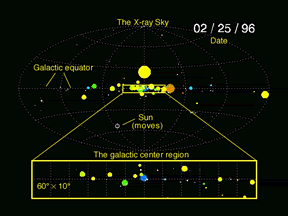Imagine News -- MIT animation reveals the violent X-ray sky
MIT animation reveals the violent X-ray sky with unprecedented clarity
Video showcases data from Rossi X-ray Timing Explorer
satellite
| 05 May 2000 |
If you could view the night sky with X-ray sensitive eyes, you would see a turbulent panorama of dying stars, active quasars and the extreme temperatures produced by matter falling into massive black holes at mind-boggling speeds. An animated video (see below) released by researchers at the Massachusetts Institute of Technology reveals this changing and turbulent X-ray sky during the past four years.
The video was presented at the annual American Astronomical Society (AAS) in January by Hale Bradt, a professor of physics at MIT. Professor Bradt received assistance from MIT graduate student Michael Muno, post-doctoral associate Donald Smith, and Alan Levine and Ronald Remillard, principal research scientists at MIT's Center for Space Research and Robin Corbet of NASA's Goddard Space Flight Center.
The All-Sky Monitor (ASM) is one of three instruments aboard the Rossi X-ray Timing Explorer (RXTE) satellite, launched in December 1995. It provides data on about 150 X-ray sources in near real time to scientists at NASA, MIT, and other institutions around the world. Professor Bradt and his associates used data from the ASM to create the animation. X-ray cameras in space like the Rossi give scientists a window on extremely energetic and often violent processes in the universe. The seven-minute video "demonstrates dramatically the extreme brightening, fading, disappearances and sudden appearances of these stars from 1996 to 1999," Bradt said. "By contrast, the visible sky we usually see is relatively unchanging and seemingly quite peaceful."

An artists conception of the RXTE |
Chaos in the Heavens
Neutron stars and black holes are final stages in the lives of stars. A neutron star is about 500,000 times more massive than Earth, squeezed into a sphere no larger than Manhattan. If such a compact star is in a close orbit with a normal gaseous star, gas from the normal star will be pulled toward the neutron star or black hole at very high speeds. This motional energy raises the temperature of the gas to tens of millions of degrees. At these extreme temperatures, the gas becomes a plasma, made largely of protons and electrons. This plasma radiates most of its energy in X-rays. The energy output of X-ray stars is typically 10,000 to 100,000 times that of the sun.
"This process of mass transfer from one star to another can be highly chaotic, leading to large variations in the X-ray brightness," project assistant Michael Muno said. Some X-ray stars, usually too faint to be seen by most instruments, will flare brightly for a few hours, days, weeks or months and then disappear. These are called transient sources or X-ray novae. Supernova remnants--leftover nebulae from the collapse of stars--are steady emitters of X-rays. Active galactic nuclei--most likely massive black holes in the centers of distant galaxies--undergo violent flaring. The ASM animation reveals a few such events, but because of their great distances, they are faint in the ASM data
The Animation
 A single frame from the ASM animation, showing the expanded galactic center region. The Sun is shown as an empty circle and moves across the image throughout the movie. |
The animation depicts X-ray stars, supernova remnants, active galactic nuclei, and quasars on a map of the entire sky, using the plane of our galaxy as the center line. Most of the X-ray stars and other objects are pinpoints, just like visible stars. But to better illustrate variations in brightness, the animation shows these objects as colored circles. Larger circles represent brighter objects. The color of the circle is the "X-ray color:" Blue generally represents higher-temperature gases and red represents lower-temperature gases.
The animation runs about 350,000 times faster than actual time. Four days pass in about one second, and the entire four years passes by in around seven minutes. The rectangular image below the sky image is a magnification of the center of our Milky Way galaxy, which has a high density of X-ray stars.
Because of the size and length of the animation, we've created two smaller excerpts you here. Clip #1 depicts the x-ray sky from April 30, 1999 through June 30, 1999. In this excerpt, a black hole on the left varies both in the X-ray wavelengths it emits (temperature) and in its brightness. The two neutron star binary systems on the right also exhibit variation in their brightness and energy as the neutron stars and their companion stars (not visible in this animation) orbit each other. (Clip 1 Description)
Clip #2 depicts the x-ray sky from March 2, 1996 through May 11, 1996; and then again from August 26, 1996 through October 15, 1996. This clip shows a number of variable x-ray objects near the center of our galaxy. It also points out two steady x-ray sources: the Crab Nebula and the supernova remnant in Cassiopeia A. (Clip 2 Description)
Please note: To view the clips, you must have a JavaScript capable-browser and a QuickTime plug-in. The files are large, and may take a few minutes to load.

